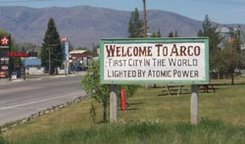Arco, Idaho
Arco, Idaho (43°38'5" North, 113°18'5" West) was the first city in the world to receive its electricity from nuclear power on July 17, 1955. At the conclusion of World War II, the U.S. became interested in developing nuclear energy as a power source. A series of wartime efforts, as part of the Manhattan Project, led to the discovery of a sustained fission reaction by Enrico Fermi in 1942, the first explosion of the atomic bomb in 1945, and eventually the bombings of Japan that brought WWII to an end on September 2, 1945. The newly-created Atomic Energy Commission established the National Reactor Testing Station (NRTS) in 1949 to research and test the potential for nuclear energy.
The NRTS, now the Idaho National Laboratory (INL), is located in the Idaho desert between the towns of Arco and Idaho Falls. The Idaho site was chosen because its remote location was ideal for the potentially hazardous reactor experiments. The complex was built on government-owned land that had originally been used as the Naval Proving Grounds where reclined big guns were test-fired during WWII. Construction of the NRTS began in 1950.
On December 20, 1951, the Experimental Breeder Reactor Number 1 (EBR-1) produced electricity that illuminated four light bulbs. In 1953, the EBR-1 first demonstrated the nuclear breeding process in which fertile isotopes are converted to fissile isotopes. The nuclear power plant was capable of producing over 2,000 kilowatts of electricity. Five boiling water reactors were built between 1953 and 1963. These reactors were part of the Boiling Water Reactor Experiment (BORAX), and the facilities were named BORAX-I through BORAX-V.
On July 17, 1955, electricity generated by uranium-fueled nuclear power from BORAX-III was fed into the transmission lines powering Arco, Idaho, a town of 1,000 approximately 20 miles from the NRTS. Arco thus became the first city in the world to receive all of its electricity from atomic energy. The town was first cut off from all other sources of power and the nuclear-powered electricity was sustained for over an hour. The test was intended to demonstrate the feasibility and safety of nuclear power generation.
Over 40 other reactors were designed and tested at the facility throughout the 1940’s and 50’s. The NRTS was also the site of the first fatal nuclear accident in the U.S. which killed three men on July 3, 1961. The men were working in the experimental reactor Stationary Low-Power Plant Number 1 when one of the control rods was removed from the reactor improperly. This led to a core meltdown and eventual explosion of the reactor.
The INL is still in operation today as an experimental facility. It includes the Advanced Test Reactor that tests new fuels and other reactor components. The INL has also developed trial reactors for U.S. Navy ships and is actively pursuing solutions for nuclear waste management. The INL is also leading the Next Generation Power Plant Project, which aims to produce hydrogen fuel from nuclear energy, or electricity-hydrogen cogeneration.
The town of Arco is known for this historical experiment, and nuclear power continues to be an important part of the town’s heritage and activities. Much of the local economy of the small town is supported by ranching and tourism, but approximately 200 Arco residents are employed at the INL. EBR-1, the reactor that first produced atomic energy on December 20, 1951, is now a national historic site. The events which took place at the NRTS spurred the development of nuclear power in the U.S. Today, 104 nuclear power plants operate in the U.S. and these plants contribute approximately 20% of the nation’s electricity.
Further Reading
- Energy Information Administration. Nuclear Energy Timeline for Kids.
- Energy Information Administration. Information on U.S. Nuclear Reactors.
- Idaho National Laboratory. Idaho National Laboratory’s Nuclear Contributions.
